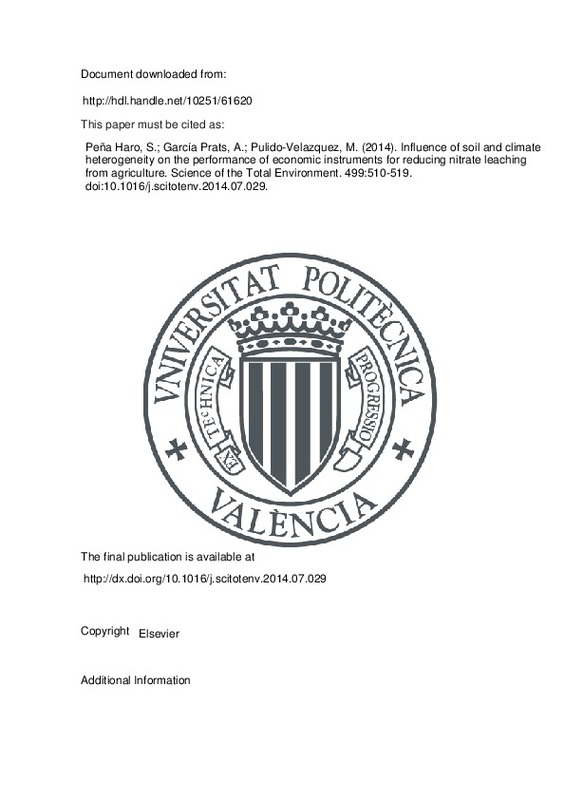JavaScript is disabled for your browser. Some features of this site may not work without it.
Buscar en RiuNet
Listar
Mi cuenta
Estadísticas
Ayuda RiuNet
Admin. UPV
Influence of soil and climate heterogeneity on the performance of economic instruments for reducing nitrate leaching from agriculture
Mostrar el registro sencillo del ítem
Ficheros en el ítem
| dc.contributor.author | Peña Haro, Salvador
|
es_ES |
| dc.contributor.author | García Prats, Alberto
|
es_ES |
| dc.contributor.author | Pulido-Velazquez, M.
|
es_ES |
| dc.date.accessioned | 2016-03-09T13:48:32Z | |
| dc.date.available | 2016-03-09T13:48:32Z | |
| dc.date.issued | 2014-11-15 | |
| dc.identifier.issn | 0048-9697 | |
| dc.identifier.uri | http://hdl.handle.net/10251/61620 | |
| dc.description.abstract | Economic instruments can be used to control groundwater nitrate pollution due to the intensive use of fertilizers in agriculture. In order to test their efficiency on the reduction of nitrate leaching, we propose an approach based on the combined use of production and pollution functions to derive the impacts on the expected farmer response of these instruments. Some of the most important factors influencing nitrate leaching and crop yield are the type of soil and the climatic conditions. Crop yield and nitrate leaching responses to different soil and climaticconditions were classified by means of a cluster analysis, and crops located in different areas but with similar response were grouped for the analysis. We use a spatial economic optimization model to evaluate the potential of taxes on nitrogen fertilizers, water prices, and taxes on nitrate emissions to reduce nitrate pollution, as well as their economic impact in terms of social welfare and farmers' net benefits. Themethod was applied to theMancha Oriental System(MOS) in Spain, a large area with different soil types and climatic conditions.We divided the study area into zones of homogeneous crop production and nitrate leaching properties. Results how spatially different responses of crop growth and nitrate leaching, proving howthe cost-effectiveness of pollution control instruments is contingent upon the spatial heterogeneities of the problem. | es_ES |
| dc.description.sponsorship | The study has been supported by the European Community 7th Framework Project GENESIS (226536) on groundwater. | en_EN |
| dc.language | Inglés | es_ES |
| dc.publisher | Elsevier | es_ES |
| dc.relation | European Community 7th Framework Project GENESIS (226536) | es_ES |
| dc.relation.ispartof | Science of the Total Environment | es_ES |
| dc.rights | Reserva de todos los derechos | es_ES |
| dc.subject | Economic instruments | es_ES |
| dc.subject | Soil and climate heterogeneity | es_ES |
| dc.subject | Nitrate leaching | es_ES |
| dc.subject.classification | INGENIERIA HIDRAULICA | es_ES |
| dc.title | Influence of soil and climate heterogeneity on the performance of economic instruments for reducing nitrate leaching from agriculture | es_ES |
| dc.type | Artículo | es_ES |
| dc.identifier.doi | 10.1016/j.scitotenv.2014.07.029 | |
| dc.relation.projectID | info:eu-repo/grantAgreement/EC/FP7/226536/EU/Groundwater and dependent Ecosystems: NEw Scientific basIS on climate change and land-use impacts for the update of the EU Groundwater Directive/ | |
| dc.rights.accessRights | Abierto | es_ES |
| dc.contributor.affiliation | Universitat Politècnica de València. Departamento de Ingeniería Hidráulica y Medio Ambiente - Departament d'Enginyeria Hidràulica i Medi Ambient | es_ES |
| dc.description.bibliographicCitation | Peña Haro, S.; García Prats, A.; Pulido-Velazquez, M. (2014). Influence of soil and climate heterogeneity on the performance of economic instruments for reducing nitrate leaching from agriculture. Science of the Total Environment. 499:510-519. https://doi.org/10.1016/j.scitotenv.2014.07.029 | es_ES |
| dc.description.accrualMethod | S | es_ES |
| dc.relation.publisherversion | http://dx.doi.org/10.1016/j.scitotenv.2014.07.029 | es_ES |
| dc.description.upvformatpinicio | 510 | es_ES |
| dc.description.upvformatpfin | 519 | es_ES |
| dc.type.version | info:eu-repo/semantics/publishedVersion | es_ES |
| dc.description.volume | 499 | es_ES |
| dc.relation.senia | 275889 | es_ES |







![[Cerrado]](/themes/UPV/images/candado.png)

